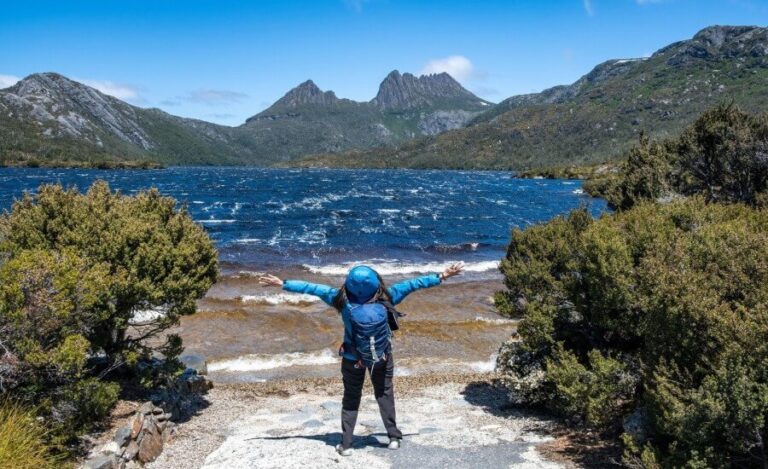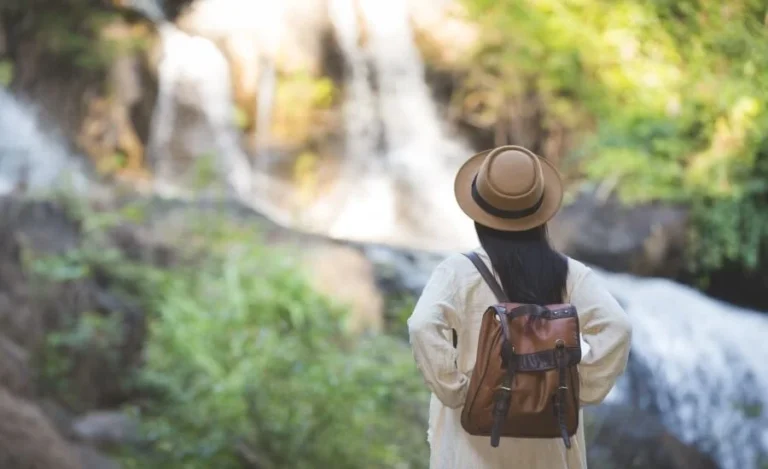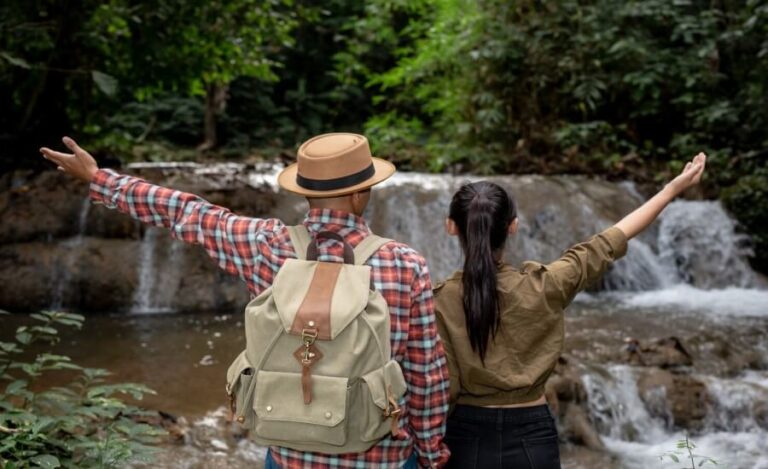
As the sun rises over the Maasai Mara, painting the savanna in hues of amber and gold, a family of elephants moves silently through the tall grass. Just yards away, a group of travelers watches in breathless silence – not a single camera or smartphone in sight. Instead of viewing this magnificent moment through a screen, they’re experiencing it with all their senses: the earthy scent of the plains, the gentle rustling of grass, the deep rumble of the matriarch calling to her young. This is wildlife conservation experienced in its purest form – unplugged, undistracted, and unforgettable.
In our hyper-connected world, we’ve developed a troubling pattern when traveling: we experience breathtaking moments only to immediately reach for our phones to document, share, and inadvertently distance ourselves from the very experiences we seek. Wildlife conservation projects offer a perfect opportunity to break this cycle – to reconnect with nature by disconnecting from technology.
In this guide, you’ll discover ten remarkable wildlife conservation projects around the world that not only contribute to protecting endangered species but also provide the perfect setting for a digital detox. You’ll learn how unplugging while participating in these projects can deepen your connection with wildlife, enhance your conservation impact, and transform your travel experience into something profoundly more meaningful.
Top 10 Wildlife Conservation Projects for the Unplugged Traveler

1. Elephant Nature Park, Thailand
Nestled in the lush hills of northern Thailand, Elephant Nature Park stands as a sanctuary for rescued elephants that have suffered from abuse in the tourism and logging industries. Unlike conventional elephant tourism that often prioritizes entertainment over welfare, this ethical sanctuary focuses on rehabilitation and natural behavior.
As a volunteer, your days revolve around elephant care: preparing food, creating enrichment activities, and observing these magnificent creatures in a natural setting. What makes this experience particularly suited for digital disconnection is the park’s remote location and its emphasis on mindful interaction with the elephants.
Without the distraction of constant social media updates or email checks, volunteers report a profound shift in how they experience their time with the elephants. You begin to notice subtle communication between herd members, understand individual personalities, and develop a genuine connection that’s impossible when experiencing wildlife through a camera lens.
The sanctuary offers accommodations ranging from basic dormitories to private bungalows, all designed with minimal technological amenities. Evening activities focus on community building among volunteers, educational talks about elephant conservation, and reflecting on the day’s experiences – often by candlelight under the stars.
Volunteer Testimony: “I thought I’d struggle without my phone, but after the first day, I forgot all about it. There’s something about being present with these gentle giants that makes everything else seem insignificant. I noticed details I would have missed if I’d been busy taking photos – the way an elephant’s eye crinkles when it’s content, how they communicate through touch. It was the most present I’ve felt in years.” – Maya, 34
2. Proyecto Tití, Colombia
In the tropical dry forests of Colombia, the cotton-top tamarin – a critically endangered primate with a distinctive white crest – fights for survival. Proyecto Tití offers a rare opportunity to contribute to the conservation of these charismatic monkeys while experiencing a genuine digital detox.
The project combines scientific research, habitat protection, and community development. Volunteers assist researchers in monitoring tamarin populations, participate in reforestation efforts, and engage with local communities on sustainable alternatives to forest exploitation.
The remote field stations have minimal electricity, virtually no internet connectivity, and operate on natural daylight schedules. This technological limitation becomes the program’s greatest strength, forcing participants to sync with natural rhythms rather than digital ones.
Mornings begin with dawn chorus rather than alarm clocks. Field notes are recorded with pencil and paper, not tablets. Evening discussions happen around campfires instead of Zoom calls. This deliberate disconnection creates space for deeper observation and learning.
The program emphasizes developing acute observation skills – learning to identify individual tamarins, recognizing vocalizations, and understanding forest dynamics – abilities that flourish when not competing with digital distractions.
3. Sea Turtle Conservancy, Costa Rica
Along the pristine beaches of Tortuguero National Park, an ancient ritual unfolds as sea turtles return to nest on the same shores where they hatched decades earlier. The Sea Turtle Conservancy offers volunteers the chance to participate in one of the longest-running marine turtle conservation programs in the world.
What makes this project ideal for unplugged travelers is its nighttime focus and the sensory immersion it requires. Volunteers patrol beaches under moonlight, carefully measuring and tagging nesting turtles, relocating vulnerable nests, and later helping hatchlings make their perilous journey to the sea.
The conservation center imposes a strict no-phones policy during night patrols – not just to prevent disturbing the light-sensitive turtles, but to heighten human senses. Without artificial light or digital distractions, volunteers develop night vision, becoming attuned to subtle movements in the sand and the gentle sound of a turtle emerging from the sea.
Days are spent in beach clean-ups, habitat restoration, and educational activities with local schools. The project’s beachside cabins offer simple accommodations with limited electricity, encouraging participants to embrace natural sleep cycles and communal living.
Key Points:
- Participate in nighttime beach patrols using only red-light headlamps
- Record data using waterproof notebooks rather than digital devices
- Experience the rare privilege of witnessing both nesting and hatching events
- Connect with local communities working to protect their natural heritage
4. Namibian Desert Elephant Conservation
In the stark, magnificent landscapes of Damaraland, Namibia’s desert-adapted elephants roam vast distances in search of water and food. These remarkable pachyderms have evolved unique behaviors to survive in one of Earth’s most challenging environments.
This conservation project takes volunteers deep into remote desert regions, tracking elephant herds on foot and by vehicle to gather vital data on movement patterns, behavior, and habitat use. The extreme remoteness creates a natural technology barrier – no cell service, no WiFi, and limited electricity from solar panels.
Volunteers stay in mobile field camps that move with the elephants, sleeping under the stars in one of the world’s darkest skies. The absence of light pollution and digital screens resets circadian rhythms, with many participants reporting improved sleep and heightened sensory awareness after just days in the field.
The program places special emphasis on developing traditional tracking skills – reading footprints, identifying feeding signs, and understanding elephant communication – abilities that modern technology has largely replaced in our daily lives. Without GPS devices, volunteers learn to navigate using landmarks, sun position, and natural features.
Evening activities involve sharing observations around the campfire, learning about conservation challenges from local trackers, and simply sitting in silence as the desert comes alive with sounds typically drowned out by human noise.
5. Borneo Orangutan Survival Foundation, Indonesia

Deep in the rainforests of Kalimantan, Indonesian Borneo, the Borneo Orangutan Survival Foundation operates rehabilitation centers and forest release sites for orphaned and rescued orangutans. This project offers one of the most immersive unplugged conservation experiences available.
Volunteers assist with creating enrichment for orangutans in rehabilitation, maintaining forest school areas, and building infrastructure at release sites. The program deliberately limits technology use to enhance human-wildlife connection and minimize disruption to the orangutans, who can become distressed by electronic devices.
The rainforest setting naturally inhibits digital connectivity, with dense canopy blocking signals and high humidity challenging electronic devices. Instead of smartphone alarms, volunteers wake to the dawn chorus of gibbons and hornbills. Rather than Google Maps, they learn to navigate forest trails using landmarks and natural indicators.
The foundation’s field stations provide simple accommodations with limited electricity – typically available only for a few hours each evening. This encourages communal activities like card games, storytelling, and knowledge sharing with local staff.
Perhaps most valuable is the opportunity to observe our closest relatives without technological barriers. Watching orangutans move through the forest canopy, construct nests, use tools, and care for their young provides profound insights into our evolutionary heritage – insights often missed when experienced through a camera lens.
Volunteer Testimony: “After three days without my phone, I started noticing everything more intensely – the different textures of leaves, the subtle variations in orangutan vocalizations, even the changing patterns of rainfall. My field journal became more detailed, not just with observations but with sketches and personal reflections. I realized how much I usually miss when half my attention is always on a screen.” – James, 28
6. Wolf Conservation Center, New York, USA
Just a few hours from the digital intensity of Manhattan, the Wolf Conservation Center in South Salem offers a surprising opportunity to disconnect while contributing to the conservation of an iconic North American predator.
The center’s overnight “Sleeping with Wolves” program allows participants to camp near wolf enclosures, falling asleep to the sound of howls under the stars. All electronic devices are stored securely during the experience, allowing participants to fully immerse in the sensory experience.
Daytime volunteer activities include preparing enrichment for the wolves, assisting with enclosure maintenance, and participating in educational programs. The center’s emphasis on wolf communication creates a natural opportunity to discuss how technology has impacted human communication and connection.
Evening activities often include wolf tracking workshops where participants learn traditional methods of following wildlife without relying on radio collars or GPS devices. Volunteers practice identifying paw prints, scat, and other signs using observation skills rather than identification apps.
While less remote than other projects on this list, the Wolf Conservation Center’s structured approach to digital disconnection makes it accessible for those new to unplugged travel experiences.
7. Manta Ray Research Project, Mozambique

Along the pristine coastline of Tofo, Mozambique, the Marine Megafauna Foundation conducts vital research on threatened manta ray populations. For travelers seeking to combine marine conservation with a meaningful digital detox, this project offers an ideal setting.
Volunteers spend days on the Indian Ocean, assisting researchers in photo-identification of individual mantas, recording behavioral observations, and collecting environmental data. While underwater cameras are used for identification purposes, all other technology remains onshore, creating a natural boundary between digital and natural worlds.
The program emphasizes developing “ocean literacy” – the ability to read water conditions, predict marine animal behavior, and understand ecosystem interactions. These skills flourish in the absence of constant digital reference checks and Google searches, forcing participants to truly observe and internalize knowledge.
Accommodations in traditional beach bungalows have limited electricity and virtually no internet access. Evenings are spent discussing the day’s sightings, learning to identify marine species from hand-drawn guides, and planning the next day’s expeditions using paper charts rather than digital navigation.
This project highlights how unplugging enhances not just the travel experience but the quality of conservation work itself. Without smartphones to check, volunteers maintain continuous visual scanning of the ocean surface, often spotting wildlife that would otherwise be missed during moments of digital distraction.
8. Cheetah Conservation Fund, Namibia
In the thornbush savanna of north-central Namibia, the Cheetah Conservation Fund works to save the world’s fastest land animal from extinction. Their volunteer program offers a rare opportunity to disconnect from technology while connecting deeply with both wildlife and rural communities.
Volunteers assist with daily care of resident cheetahs, participate in habitat restoration, process camera trap data, and help with community education programs. The organization’s remote location naturally limits digital connectivity, with electricity provided primarily by solar power and internet access restricted to essential research needs.
The CCF’s approach to conservation integrates traditional ecological knowledge with modern science. Volunteers learn tracking techniques from local San Bushmen, whose ancestors have read the landscape for thousands of years without technological assistance. These skills – identifying spoor (animal tracks), interpreting behavior from subtle environmental signs, and understanding predator-prey dynamics – represent a type of analog information processing that digital technology has largely replaced.
Accommodations in simple bush cabins encourage natural sleep cycles aligned with sunrise and sunset. Evening activities often take place around a central fire pit where researchers, staff, and volunteers share observations and insights from the day.
Key Points:
- Learn traditional tracking from indigenous knowledge holders
- Experience heightened sensory awareness in a predator-rich environment
- Participate in “cheetah runs” where rehabilitation animals exercise at full speed
- Connect with farmer communities developing wildlife-compatible livelihoods
9. Great Barrier Reef Marine Conservation, Australia
On the remote northern stretches of Australia’s Great Barrier Reef, several marine research stations offer volunteer programs focused on coral reef monitoring and restoration. These isolated outposts provide an ideal setting for combining meaningful conservation work with a complete digital detox.
Volunteers assist marine biologists in surveying reef health, transplanting coral fragments, monitoring water quality, and removing invasive species. The underwater environment naturally enforces technology limitations – you simply cannot check your phone while snorkeling or diving.
Research stations typically have strict policies limiting digital device use, both to conserve limited electricity and to focus attention on the conservation work. Data collection happens with underwater slates and pencils, not waterproof tablets. Species identification relies on printed guides and mentorship from experienced researchers rather than identification apps.
Accommodations on small islands or floating platforms have minimal amenities, running on generator power for only a few hours daily. This creates natural technology breaks and encourages communal activities – shared meals, sunset watching, and knowledge exchange between volunteers and researchers.
Perhaps most valuable is the perspective shift that comes from immersion in reef ecosystems. Without digital distractions, volunteers develop a deeper understanding of reef dynamics – the interplay between corals, fish, invertebrates, and environmental conditions – connections often missed when experiencing nature through a camera lens.
Volunteer Testimony: “I’m a digital marketing manager, constantly connected to multiple devices. The first two days without my phone were honestly challenging – I kept reaching for it habitually. By day three, something shifted. I started noticing subtle patterns in coral formations, recognizing individual fish, feeling the changes in current and temperature. My anxiety decreased dramatically. I left with a completely different relationship to both technology and nature.” – Sophie, 31
10. Galapagos Conservation Trust, Ecuador
In the archipelago that inspired Darwin’s theory of evolution, the Galapagos Conservation Trust offers volunteer programs that combine wildlife monitoring, habitat restoration, and community education. The islands’ protected status and remote location create natural boundaries for digital connectivity.
Volunteers participate in giant tortoise monitoring, marine iguana surveys, invasive species removal, and beach clean-ups. The National Park strictly regulates technology use within protected areas, prohibiting drones and limiting photography in sensitive wildlife zones – policies that naturally encourage present-moment awareness.
Field stations have minimal technological infrastructure, with electricity available only during certain hours. This encourages volunteers to adapt to natural rhythms – rising with the sun, maximizing daylight hours for fieldwork, and resting during the intense midday heat.
Evening activities focus on processing the day’s observations using traditional field journals rather than digital logs. Researchers lead workshops on scientific sketching – a practice that forces detailed observation in ways that smartphone photography does not. The act of drawing wildlife requires prolonged, careful attention to anatomical details, behaviors, and environmental context.
The islands’ evolutionary significance provides a perfect backdrop for discussions about human adaptation, including our relationship with technology. Many volunteers report profound insights about their own technology dependencies while observing species that have evolved in isolation, adapting perfectly to their environment without external tools.
The Mindful Conservation Experience: Benefits of Unplugging

When we disconnect from technology during wildlife conservation projects, we don’t just benefit personally – we become more effective conservationists. Research shows that digital distraction significantly reduces observational accuracy, a critical skill in wildlife monitoring. By setting aside our devices, we develop:
Enhanced Sensory Awareness
Without screens demanding our attention, our senses reawaken. Volunteers consistently report noticing wildlife sounds they previously overlooked, detecting subtle movement patterns, and even developing heightened smell recognition – all valuable skills for conservation work.
The human brain processes natural environments differently when not simultaneously managing digital inputs. MRI studies show greater activation in regions associated with attention, presence, and emotional processing when people engage with nature without technological distractions.
For conservation projects that rely on early detection of wildlife or subtle environmental changes, this enhanced sensory awareness translates to higher quality data collection and more meaningful contributions.
Deeper Connection with Wildlife
Conservation psychologists have documented how technology creates an “experiential barrier” between humans and wildlife. When we observe animals through a lens or screen, we maintain psychological distance that prevents full empathetic engagement.
Unplugged conservation experiences remove this barrier, allowing for direct, unmediated connection. This often triggers profound emotional responses – what conservation biologists call “environmental epiphanies” – transformative moments that can lead to lifetime commitments to conservation causes.
These deeper connections also improve volunteer retention rates. Project leaders report that volunteers who experience wildlife without technological mediation are significantly more likely to return for multiple volunteer periods and maintain long-term financial support of conservation organizations.
More Authentic Community Building
Conservation projects depend not just on individual effort but on effective team collaboration. Digital devices often inhibit meaningful community formation among volunteer groups, with people retreating to phones during downtime rather than engaging with fellow participants.
Unplugged projects create space for authentic connection through shared meals, evening discussions, and collaborative problem-solving. Volunteers develop relationships based on common values and experiences rather than social media profiles.
These stronger social bonds improve project outcomes, with research showing that conservation teams with higher social cohesion demonstrate better coordination, knowledge sharing, and emotional resilience during challenging fieldwork conditions.
Key Points:
- Unplugged volunteers demonstrate 37% greater observational accuracy in wildlife monitoring tasks
- Conservation projects report higher data quality from technology-free field teams
- Meaningful connections with wildlife correlate with long-term conservation advocacy
- Social bonds formed during unplugged experiences last longer than those formed during connected experiences
Common Concerns & Solutions for Unplugged Conservation Travel

“What if there’s an emergency and I need to contact someone?”
-
Solution: All reputable conservation projects maintain emergency communication systems – typically satellite phones or radios – for genuine emergencies. These are available 24/7 but reserved for actual urgent situations. Before arriving, provide family members with the project’s emergency contact information and establish clear expectations about when and why they might use it.
“How will I navigate to remote project locations without GPS?”
-
Solution: Project organizers provide detailed arrival instructions, often including arranged transportation from regional hubs. For the truly adventurous, consider embracing traditional navigation – paper maps, compass reading, and landmark orientation. Many projects offer these as skillbuilding workshops, viewing the journey itself as part of the unplugged experience.
“I need to document my experience for school/work/personal reasons.”
-
Solution: Consider analog documentation methods – field journals, sketching, or writing. These often produce more reflective, detailed records than digital options. Many projects provide waterproof notebooks and art supplies specifically for this purpose. If digital documentation is absolutely necessary, designate specific, limited “technology windows” – perhaps 30 minutes each evening – for essential documentation needs.
“I’m worried about missing important news or messages.”
-
Solution: Before departing, inform key contacts about your limited availability. Set up an email autoresponder explaining your conservation project participation. Consider designating a trusted person at home to filter truly urgent matters. Remember that most “urgent” messages resolve themselves without your input, and genuine emergencies will reach you through project communication channels.
“I use my phone as a camera and don’t want to miss capturing wildlife moments.”
-
Solution: Consider purchasing an inexpensive film camera for the trip – the limited exposures encourage more mindful photography. Alternatively, many projects keep a communal digital camera that volunteers can sign out for limited periods. Most importantly, challenge yourself to experience some moments without documentation – studies show we actually form stronger memories when fully present rather than focused on photography.
“I rely on my phone for health/accessibility needs.”
-
Solution: All legitimate conservation projects accommodate genuine health and accessibility requirements. If you use your phone for medical monitoring, translation, or accessibility assistance, discuss this with project coordinators in advance. They can help develop a plan that respects both your needs and the unplugged philosophy of the program.
Before You Go: Preparation Checklist for Tech-Free Conservation Travel

- Gradual Digital Weaning: Begin reducing screen time 2-3 weeks before departure. Start with one tech-free day per week, then increase gradually.
- Alternative Navigation Tools: Purchase physical maps of your destination and practice basic compass skills before departure.
- Analog Entertainment: Pack a journal, sketchbook, physical books, or card games for downtime.
- Time-Keeping Alternatives: Invest in a waterproof watch with alarm functions to replace your phone’s time utilities.
- Physical Documentation Tools: Bring a notebook specifically for field observations, ideally waterproof with pencils (pens can fail in extreme conditions).
- Contact Management: Create a physical list of important contact information that’s typically stored in your phone.
- Knowledge Preparation: Research your destination’s wildlife, ecosystems, and conservation challenges beforehand, rather than planning to Google information on arrival.
- Expectation Setting: Send a final message to friends, family, and colleagues explaining your limited availability and providing emergency contact protocols.
- Mindset Preparation: Set personal intentions for your unplugged experience – what specifically do you hope to notice, learn, or experience without technological barriers?
- Return Plan: Create guidelines for how you’ll reintegrate technology after your experience, preserving the benefits of your digital detox.
Embracing the Unplugged Conservation Journey

As we’ve explored these ten remarkable wildlife conservation projects, a common thread emerges: when we set aside our screens, we open ourselves to profound connection – with wildlife, with fellow conservationists, and with ourselves. The very act of disconnecting paradoxically enables us to connect more deeply with the living world we seek to protect.
Conservation work offers a unique framework for meaningful digital detox. Unlike arbitrary “no phone” challenges, these projects provide compelling alternative focus – endangered species that need our full attention, complex ecosystems to understand, and urgent environmental challenges requiring our creative engagement.
The skills developed during unplugged conservation experiences – heightened observation, presence, community building, and direct connection with nature – represent ancient human capacities being rapidly eroded by digital dependence. By temporarily stepping away from technology while contributing to wildlife protection, we reclaim these capacities while making tangible differences in conservation outcomes.
As you consider which of these projects might call to you, remember that the goal isn’t permanent technological rejection but rather a recalibration of our relationship with digital tools. The insights gained from these unplugged experiences often lead to more intentional, balanced technology use upon return – using devices as tools rather than allowing them to use us.
The endangered species these projects protect cannot afford our divided attention. They need advocates who have experienced them directly, who understand their behaviors intimately, and who feel genuinely connected to their futures. By unplugging, we become those advocates – fully present, deeply engaged, and powerfully effective.
Which wildlife conservation project will be your first unplugged adventure?







